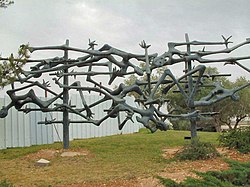| Part of a series on |
| The Holocaust |
|---|
 |
A number of organizations, museums and monuments are intended to serve as memorials to the Holocaust, the Nazi Final Solution, and its millions of victims.
Contents
- Albania
- Argentina
- Australia
- Austria
- Belarus
- Belgium
- Brazil
- Bulgaria
- Canada
- China (People's Republic of China)
- Croatia
- Cuba
- Czech Republic
- Ecuador
- Estonia
- France
- Germany
- Greece
- Guatemala
- Hungary
- Indonesia
- Israel
- Italy
- Japan
- Latvia
- Lithuania
- Luxembourg
- Mexico
- Netherlands
- Amsterdam
- Utrecht and Vught
- Westerbork
- Amersfoort
- New Zealand
- North Macedonia
- Norway
- Philippines
- Poland
- Portugal
- Romania
- Russia
- Serbia
- Slovakia
- Slovenia
- South Africa
- Spain
- Suriname
- Sweden
- Taiwan
- Ukraine
- United Kingdom
- United States
- Uruguay
- Uzbekistan
- See also
- Notes
- References
- Further reading
- External links
Memorials and museums listed by country:
A - D: Albania · Argentina · Australia · Austria · Belarus · Belgium · Brazil · Bulgaria · Canada · China (PRC) · Croatia · Cuba · Czech Republic
E - J: Ecuador · Estonia · France · Germany · Greece · Guatemala · Hungary · Israel · Italy · Japan
K - O: Latvia · Lithuania · Mexico · Netherlands · New Zealand · North Macedonia · Norway
P - T: Philippines · Poland · Portugal · Romania · Russia · Serbia · Slovakia · Slovenia · South Africa · Spain · Suriname · Sweden · Taiwan
U - Z: Ukraine · United Kingdom · United States · Uruguay
Other sections:
See also · · Notes · References · Further reading · External links














